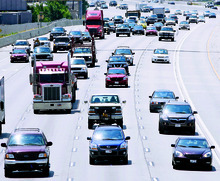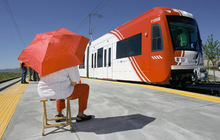This is an archived article that was published on sltrib.com in 2011, and information in the article may be outdated. It is provided only for personal research purposes and may not be reprinted.
Two new freeways, several new streetcars and TRAX lines, and hundreds of miles of new "bus rapid transit" — where express buses have their own highway lanes — are included in the official transportation plan for the next 30 years adopted Thursday by the Wasatch Front Regional Council.
But that final plan delays an earlier eye-catching proposal to convert Bangerter Highway into a freeway by 2040. It now calls merely to begin converting some of its intersections into freeway interchanges between 2030 and 2040, working from the south northward as funds become available. Most conversion, however, is not envisioned to begin by 2040.
"This is a big shift," said Midvale Mayor JoAnn Seghini, a council member, noting the new plan moves away from the past focus on building new highways to increased emphasis on mass transit and improvements for bicycles and pedestrians.
Council planners said such shifts are needed because Salt Lake, Davis and Weber counties covered by the plan are running out of places to build new roads, and those counties expect to increase their population 50 percent by 2040.
Still, the plan does include two new freeways in the next 30 years. They are West Davis Highway (an extension of Legacy Highway northward) and Mountain View Corridor in western Salt Lake and Utah counties, which is under construction and like Bangerter will have portions begin as a highway and later be converted into a freeway.
The plan also includes a variety of highway widening projects, mostly to help improve east-west traffic.
That includes widening at various times in the next 30 years of 5400 South, 4700 South, 6200 South, 7000 South, 9000 South, 10400 South, 11400 South and 13400 South in Salt Lake County. The plan also calls for interchange improvements on U.S. 89 in Davis County, along Bangerter Highway and on I-15 — and also includes adding an I-215 interchange at 5400 South in Taylorsville and making State Road 201 a freeway along its entire length.
But many of the biggest changes are envisioned for mass transit.
The plan calls for nearly 270 miles of new "bus rapid transit" lines in the three counties, similar to a line now operating on parts of 3500 South in West Valley City that gives buses their own separate lanes. Planners call it a sort of "TRAX on rubber wheels" with stations and ticket-vending machines.
Among routes where bus rapid transit is envisioned are State Street, Foothill Drive-Wasatch Drive, Redwood Road, 5600 West, 5400 South, 3300/3500 South, 12300/12600 South, 1300 East, 700 East and a line that will stretch between Holladay and Taylorsville largely on 4500 South.
The plan calls for new streetcar lines — including a recently funded Sugar House line that would be extended to the University of Utah and then to downtown Salt Lake City along 200 South. Also, it envisions a streetcar in Ogden between Weber State University and Ogden's intermodal hub.
New TRAX light rail lines envisioned include the already under-construction extensions to Draper (and eventually the Utah County Line) and to Salt Lake City International Airport, plus a future line along 5600 West.
The council said the overall plan will reduce air pollutants by an estimated 154 tons a day from current levels and will decrease commuter waiting time by about half from what it would become without it. —
Transportation • Getting around the Wasatch Front in the future
• The Wasatch Front Regional Council develops updated 30-year plans every four years to set priorities, and to help coordinate urban planning by cities.
• John Njord, a board member and Utah Department of Transportation director, said only projects in the regional plan can be funded and built by UDOT.
• Details and maps of the plan are available online at wfrc.org.





